Oakwoods Country Club – Pure Golf in the Western Carolina Foothills
Like many North Carolina country clubs I have written about, Oakwoods Country Club in Wilkesboro has a rather unique story. It’s about how a group of people who all shared the same passion for golf came together to create a country club that they could all be proud of. It’s also a story about how to take a brand-new club and make it debt-free within five years.
Oakwood’s story begins in the fall of 1952 when several prominent country club-minded citizens in Wilkes County met in the Forest Hills home of Pat M. Williams, Jr. and his wife Dottie. Approximately $100,000 was pledged toward the construction of a new golf course to be designed by soon-to-be-legendary golf architects Robert Trent Jones and J.B. McGovern. in December of 1952, the Wilkes Country Club was organized at a public meeting at the North Wilkesboro Town Hall.
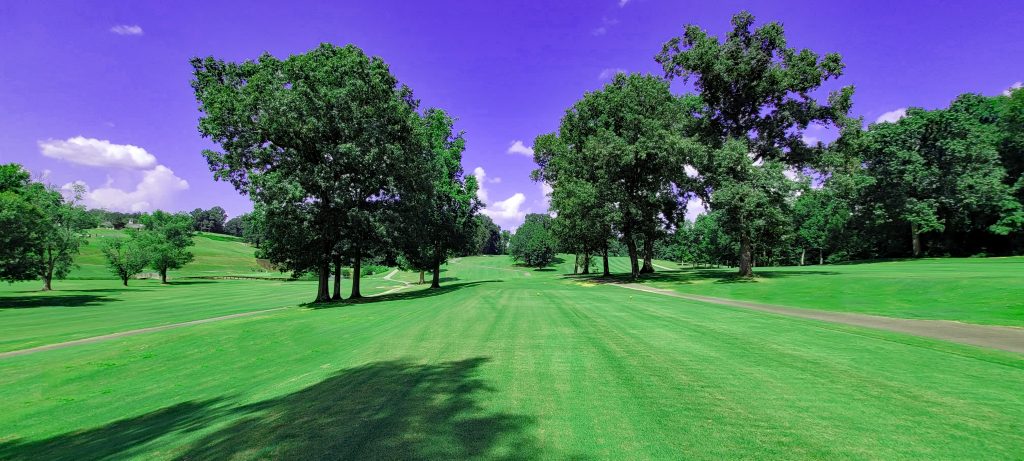 Through the purchase and the execution of options, the group was able to acquire 148 acres of land at the base of the Brushy Mountains and Jones and McGovern got to work. Construction of the original nine-hole course and clubhouse began in early spring 1953 with Arthur Ham, a venerable Scot architect, serving as the course designer. What Mother Nature didn’t provide, Arthur Ham did.
Through the purchase and the execution of options, the group was able to acquire 148 acres of land at the base of the Brushy Mountains and Jones and McGovern got to work. Construction of the original nine-hole course and clubhouse began in early spring 1953 with Arthur Ham, a venerable Scot architect, serving as the course designer. What Mother Nature didn’t provide, Arthur Ham did.
In January of 1954 Wilkes Country Club was renamed Oakwoods Country Club and opened for play during that month. It seems that a lot of what went into the clubhouse was donated or done in barter for memberships. This included the clubhouse which was built on a “cost-plus” basis. Eventually, the contractor agreed to cut his fee in half and take stock in exchange. Several local manufacturers donated furniture and a local appliance dealer outfitted the kitchen free of charge. Lockers were bought and donated to the club by members who received five years of free locker rent in payment. Hence, the original clubhouse was built for around $30,000.
Oakwood continued as a 9-hole course until 1962 when then head PGA Professional Bill Greene, age 29, was asked to supervise the construction of 9 additional holes. Just before Greene was hired by Oakwoods, noted course designer Ellis Maples had been retained to stake out a potential new nine holes of golf on property adjacent to the club. Green got to work with several other hard-working members and began the arduous process of 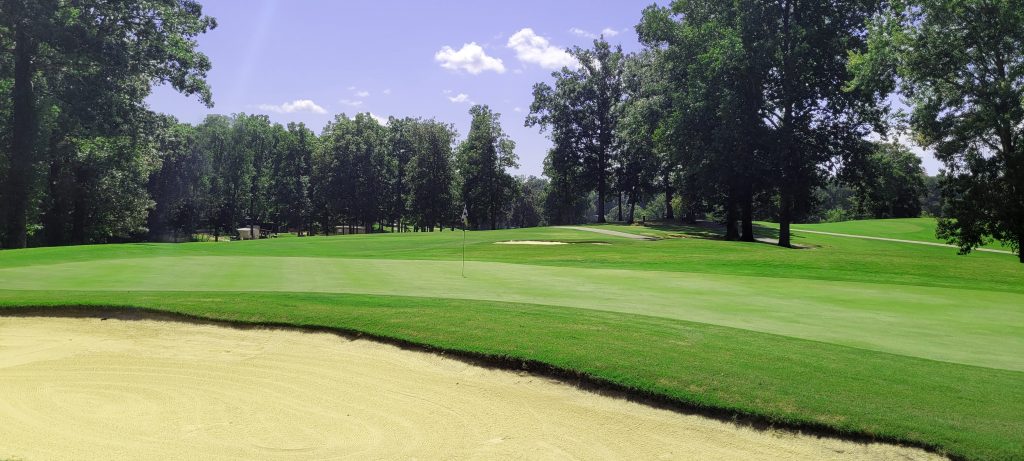 land clearing, grading, cultivation, and planting needed to bring the new nine to fruition for OCC’s avid golfer members. These additional 9 holes were built with nothing more than two 1950’s model Ford tractors, a tractor-pulled five-reel fairway mower, and a lot of blood, sweat, and tears. The new 9 featured Bermuda grass fairways and greens and opened for play in May of 1963.
land clearing, grading, cultivation, and planting needed to bring the new nine to fruition for OCC’s avid golfer members. These additional 9 holes were built with nothing more than two 1950’s model Ford tractors, a tractor-pulled five-reel fairway mower, and a lot of blood, sweat, and tears. The new 9 featured Bermuda grass fairways and greens and opened for play in May of 1963.
With nine new holes, it was time to reroute the golf course. Holes numbers 1 and 2 of the existing nine became holes 10 and 11 of what is now the back nine and the just-completed nine holes became the front nine. This routing still exists today at Oakwood Country Club. Membership – which was around 125 when Bill Greene arrived, soon swelled to over 500.
Bill Greene retired from Oakwood Country Club in 1994 after serving the club faithfully for 32 years. He passed away in 2009. Bill and his long-time assistant Billy Hayes oversaw many of the club’s amenities and improvements over the years including the building of the tennis courts and driving range (1966), the installation of an irrigation system (1969), the paving of the parking lot (1972), a much larger swimming complex (1977), the hiring of the club’s first Green’s Superintendent (1980), and the cart shed (1992).
 Dramatic elevation changes, challenging tee shots, and large undulating greens highlight your round at Oakwood Country Club. It’s a well-known fact that Oakwood has long been celebrated for the quality of its greens. You’ll encounter several water hazards and strategically placed, well-manicured bunkers
Dramatic elevation changes, challenging tee shots, and large undulating greens highlight your round at Oakwood Country Club. It’s a well-known fact that Oakwood has long been celebrated for the quality of its greens. You’ll encounter several water hazards and strategically placed, well-manicured bunkers
The first hole at Oakwoods Country Club is a 162-yard par 3 that plays straight downhill and showcases the club’s elevation changes and according to Guy Carroll, Director of Golf & Clubhouse Operations, big numbers are every bit as prevalent as low numbers. It plays around 150 yards downhill and maybe the toughest 150-yard shot you’ll ever face on a starting hole! It’s not noticeable until you get to the green but there is a creek that runs along the left side.
Number 4 is a short par 5 with a hidden agenda. At only 443 yards, you’re thinking about making up a shot or two on the competition, but not so fast. It’s a dogleg left with another blind tee shot and a small fairway bunker on the right side that catches errant layup shots. A small lake guards the right side of the green and makes you think about your second shot. Two small bunkers guard the left side of this wide, shallow green.
 Ten, 11, and 12 are a good trio of holes. Number 10 is a 388-yard par 4, which is handicapped as the second hardest hole on the course. If I were naming holes, this one would be called “Avoid the Creek,” because of the creek that bisects the fairway. Off the tee you’re faced with a choice: play left of the creek to the wider part of the fairway and have a little longer approach shot or play down the sliver of fairway on the right with a large hill and trees framing the right boundary. Or do what I do, take dead aim at the creek knowing I can’t possibly hit it straight and deal with the results. My ball chose the right side and I was left with an approach shot into a green that slopes right to left and is surrounded by four bunkers.
Ten, 11, and 12 are a good trio of holes. Number 10 is a 388-yard par 4, which is handicapped as the second hardest hole on the course. If I were naming holes, this one would be called “Avoid the Creek,” because of the creek that bisects the fairway. Off the tee you’re faced with a choice: play left of the creek to the wider part of the fairway and have a little longer approach shot or play down the sliver of fairway on the right with a large hill and trees framing the right boundary. Or do what I do, take dead aim at the creek knowing I can’t possibly hit it straight and deal with the results. My ball chose the right side and I was left with an approach shot into a green that slopes right to left and is surrounded by four bunkers.
Number 11, (par 4, 336 yards) feature a blind tee shot, and if you hit it left into the valley, you’ll be faced with a long, incredibly uphill approach shot into a small green. Number 12 is a challenging par 3 that plays downhill and slightly less than the 144 yards stated on the scorecard. The green sits out on a peninsula so choose your club carefully and make a good swing. There’s a steep hill on the left side and the ball doesn’t always roll down to the bottom. Hit your tee shot over there and you’ll be faced with a tough downhill pitch shot over a bunker onto a green with water behind it. Keep it right!
Your final hole of the day ends as it started, with a challenging 174-yard par 3 that plays uphill over water and is all carry. A single bunker guards the front left of the green and the woods to the right have collected their fair share of golf balls. Par is a great way to end.
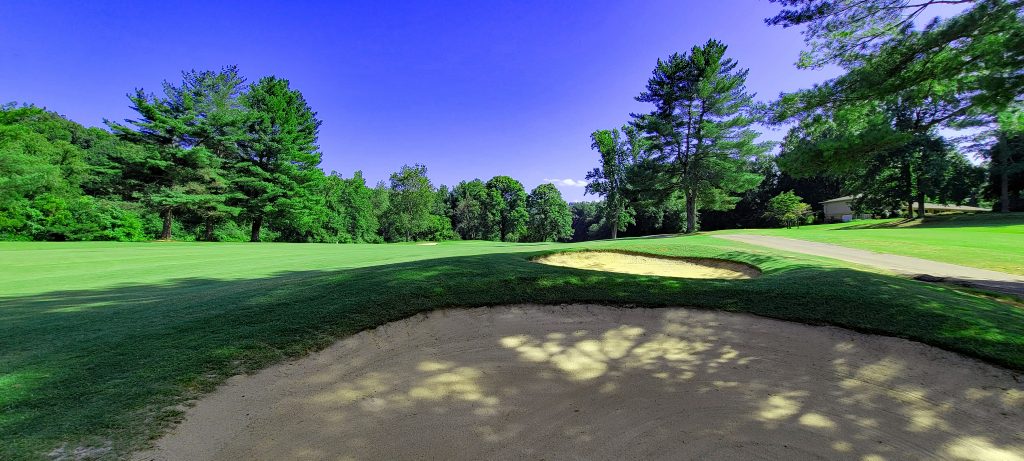 Oakwoods features a full-length driving range located across the street from the clubhouse and a large practice green behind the clubhouse so there’s no reason not to be ready when you hit the first tee. After your round, stop by the Oakwoods Grille for your favorite adult beverage and typical clubhouse fare. I can personally vouch for the grilled chicken sandwich!
Oakwoods features a full-length driving range located across the street from the clubhouse and a large practice green behind the clubhouse so there’s no reason not to be ready when you hit the first tee. After your round, stop by the Oakwoods Grille for your favorite adult beverage and typical clubhouse fare. I can personally vouch for the grilled chicken sandwich!
Last Word. Oakwoods offers a challenging golf course that is a lot of fun to play and will keep you coming back again and again. The par 3 holes at Oakwoods Country Club can make or break a great round. On the scorecard, they are handicapped 4, 5, 7, and 14 which only proves they are not pushovers.
Oakwoods Country Club is all about golf. Period. You won’t find a pristine dining room, spa, or fancy locker room. What you will find is a swimming pool and a challenging, well-maintained golf course that is affordable for any budget. There are no initiation fees and membership categories are broken down by age. A full membership won’t run you more than $195/month no matter how old you are or how much you play. Play just twice a week and you’re averaging around $25 bucks a round. If you’re an avid golfer in the area, you can’t afford not to join.
For more information, give them a call at (336) 838-3011 or visit them online at www.oakwoodscc.com and fill out a membership application.

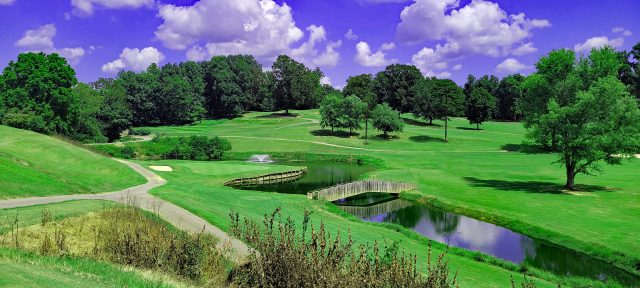


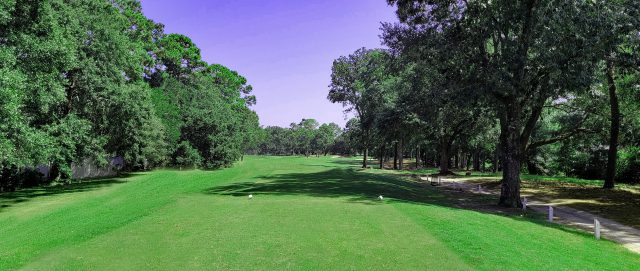
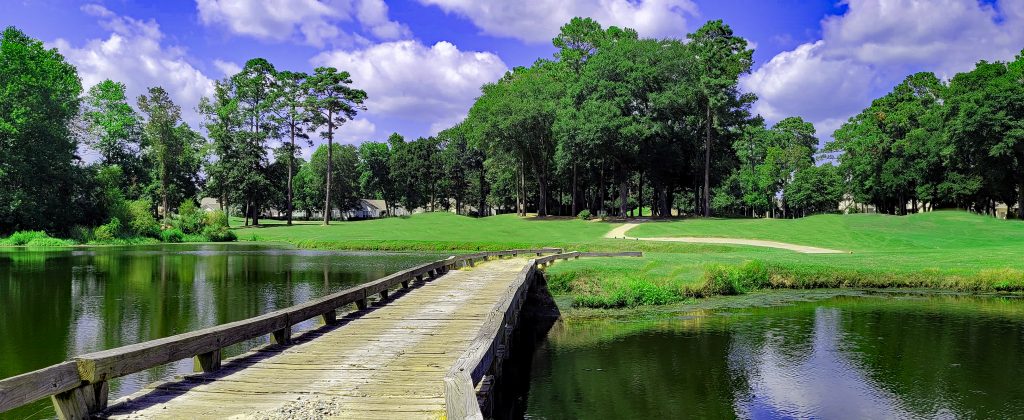 Number 1 is a 359-yard, straightaway par 4 with a lone pine tree on the right side of the fairway. It’s just far enough for most players that, if you push your tee shot right, it’s going to come into play. There’s a lot of mounding in the fairways that can lead to the dreaded uneven lie. Two bunkers protect the front.
Number 1 is a 359-yard, straightaway par 4 with a lone pine tree on the right side of the fairway. It’s just far enough for most players that, if you push your tee shot right, it’s going to come into play. There’s a lot of mounding in the fairways that can lead to the dreaded uneven lie. Two bunkers protect the front.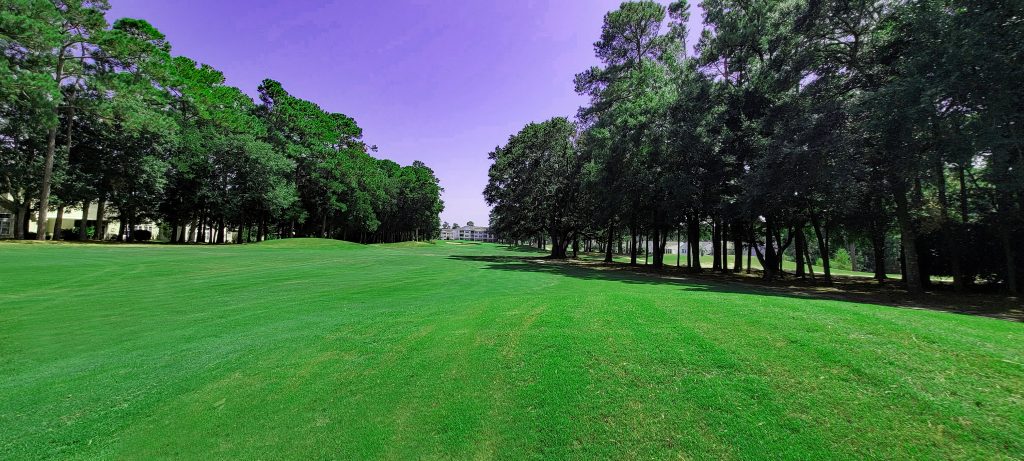 Number 7 is the longest at 190 yards from the Blue tees and although the water shouldn’t come into play, for many it does. Sand guards the right side in the form of two separate bunkers.
Number 7 is the longest at 190 yards from the Blue tees and although the water shouldn’t come into play, for many it does. Sand guards the right side in the form of two separate bunkers.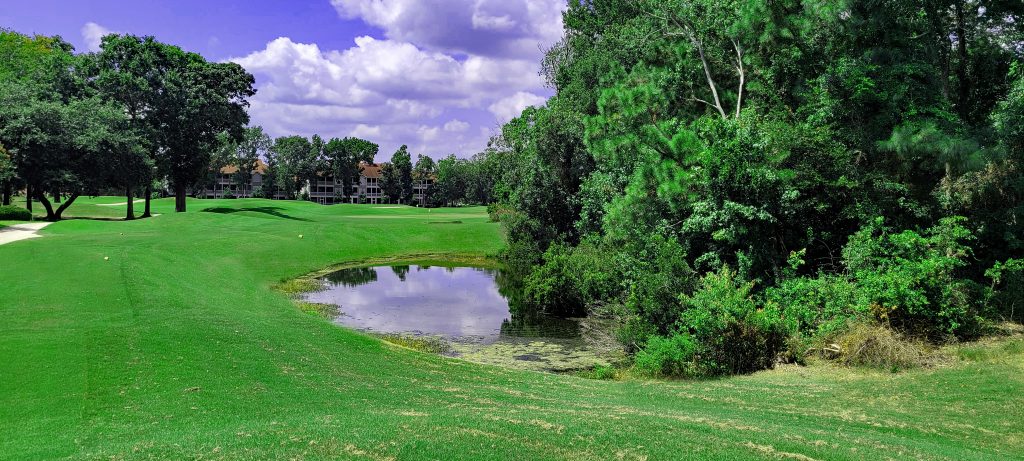 Holes 17 and 18 are two finishing holes that can make or break a great round; they are incredibly long and challenging. Number 17 is a par 4 dogleg left that plays 434 yards from the Blue tees. It requires a long drive down the right side that opens up the hole and leaves a long but unobstructed shot into the green. Anything left of the middle of the fairway will require a long approach shot over trees. Either way, you’ll need to carry the large pond that fronts the green. Hit it right of the green and you’ll most likely find the bunker.
Holes 17 and 18 are two finishing holes that can make or break a great round; they are incredibly long and challenging. Number 17 is a par 4 dogleg left that plays 434 yards from the Blue tees. It requires a long drive down the right side that opens up the hole and leaves a long but unobstructed shot into the green. Anything left of the middle of the fairway will require a long approach shot over trees. Either way, you’ll need to carry the large pond that fronts the green. Hit it right of the green and you’ll most likely find the bunker.

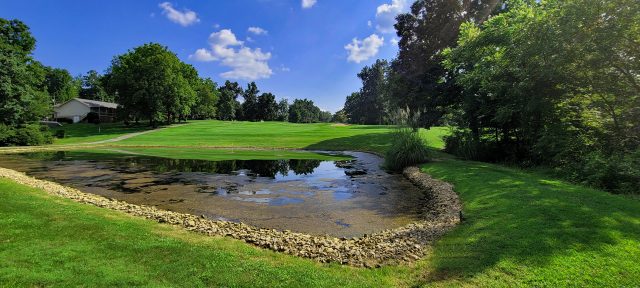
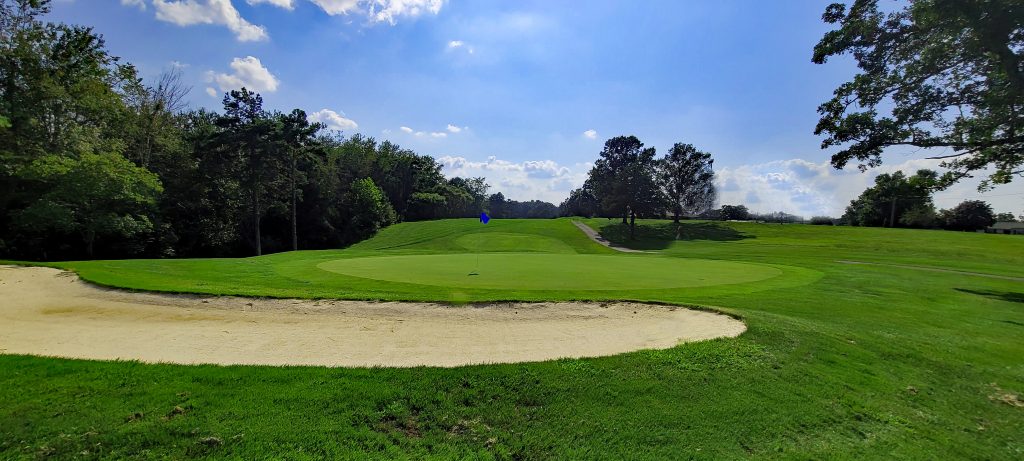 That’s just one of the positives about the course. Another would be that the course is very playable, regardless of your ability. If you’re new to the game, play from the White or Green tees, you won’t be over-powered, and you’ll have a good time. From the back tees, there are a couple of holes that will challenge the best of players. Most notably Number 13, which plays over 100 yards longer from the Blue tees than from the Green; the same is true on the 18th hole as well.
That’s just one of the positives about the course. Another would be that the course is very playable, regardless of your ability. If you’re new to the game, play from the White or Green tees, you won’t be over-powered, and you’ll have a good time. From the back tees, there are a couple of holes that will challenge the best of players. Most notably Number 13, which plays over 100 yards longer from the Blue tees than from the Green; the same is true on the 18th hole as well.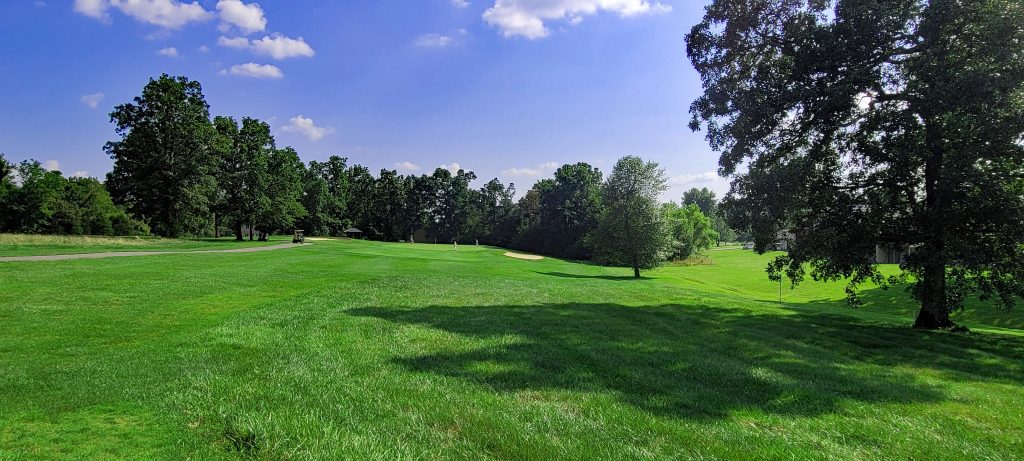 Number 6 is a 172-yard par 3 and your first real encounter with water, although for most players it shouldn’t come into play. It plays over a pond and uphill and seems to play about a club longer. Out of bounds can come up quickly out to the right. Once again, there are sand traps on either side of the green which slopes back left to front right. Regardless of pin placement, up and down from either bunker can be a daunting task. Playing from the grass mounds around the bunkers is no easy task either. You’re best to just find the green off the tee and two-putt. It’s rated the toughest par 3 on the course and is handicapped #5.
Number 6 is a 172-yard par 3 and your first real encounter with water, although for most players it shouldn’t come into play. It plays over a pond and uphill and seems to play about a club longer. Out of bounds can come up quickly out to the right. Once again, there are sand traps on either side of the green which slopes back left to front right. Regardless of pin placement, up and down from either bunker can be a daunting task. Playing from the grass mounds around the bunkers is no easy task either. You’re best to just find the green off the tee and two-putt. It’s rated the toughest par 3 on the course and is handicapped #5. Although it’s not reflected on the scorecard a lot of the golfers I play with feel that Number 15 is the toughest par 3 out here. From the White Tees, the hole plays 160 yards with a deep bunker short right and another back left. Out of bounds comes up quickly on the left; anything that side of the cart path spells trouble. The green has two distinct tiers so if you have to chip onto the green, it’s important to be on the right level.
Although it’s not reflected on the scorecard a lot of the golfers I play with feel that Number 15 is the toughest par 3 out here. From the White Tees, the hole plays 160 yards with a deep bunker short right and another back left. Out of bounds comes up quickly on the left; anything that side of the cart path spells trouble. The green has two distinct tiers so if you have to chip onto the green, it’s important to be on the right level.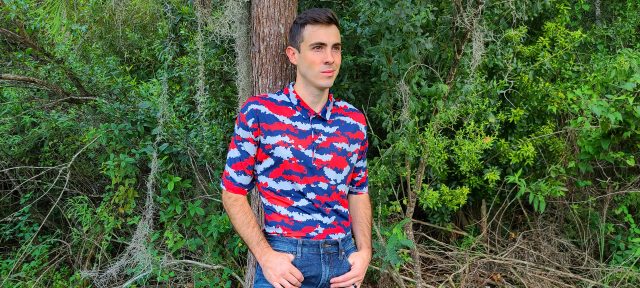
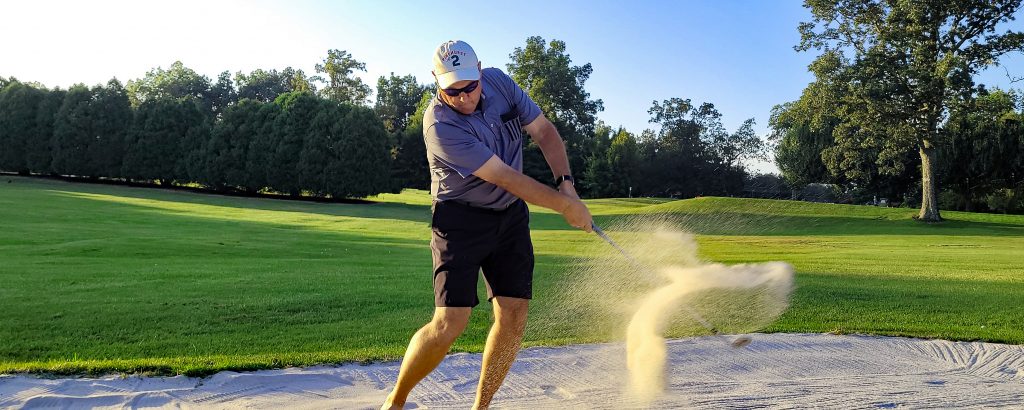 weather has to offer. It’s feature-rich with moisture-wicking, fast-drying, breathable, lightweight, and has four-way stretch. What else could you want in s golf apparel fabric? The Volition Flanked Polo also features UPF 50 sun protection woven into the fabric. The all-over camo print is sure to turn some heads. On the back of the neck there’s PUMA’s iconic CAT logo, the Volition logo and the word “America” running down the middle. This could quickly move up the ranks of becoming your favorite golf polo. The MATTR Volition Flanked Polo is available in sizes s – 3XL and in three colorways: High Risk Red, Navy Blazer, or PUMA Black.
weather has to offer. It’s feature-rich with moisture-wicking, fast-drying, breathable, lightweight, and has four-way stretch. What else could you want in s golf apparel fabric? The Volition Flanked Polo also features UPF 50 sun protection woven into the fabric. The all-over camo print is sure to turn some heads. On the back of the neck there’s PUMA’s iconic CAT logo, the Volition logo and the word “America” running down the middle. This could quickly move up the ranks of becoming your favorite golf polo. The MATTR Volition Flanked Polo is available in sizes s – 3XL and in three colorways: High Risk Red, Navy Blazer, or PUMA Black. Continuing within the Volition line, the MATTR Volition Banner Golf Polo pays homage to this great country with a Red, White, and Blue color scheme and patriotic stars and stripes. It has all of the performance features you’d expect from the MATTR fabric and the flag graphic on the chest may just have your playing partners standing at attention and saluting. Purchasing any Volition America apparel honors and supports the families of our military heroes through the Folds of Honor Foundation. This great looking polo is available in Bright White (Red/White/Blue) and Quiet Shade Gray/Black. It’s available in sizes S – 2XL.
Continuing within the Volition line, the MATTR Volition Banner Golf Polo pays homage to this great country with a Red, White, and Blue color scheme and patriotic stars and stripes. It has all of the performance features you’d expect from the MATTR fabric and the flag graphic on the chest may just have your playing partners standing at attention and saluting. Purchasing any Volition America apparel honors and supports the families of our military heroes through the Folds of Honor Foundation. This great looking polo is available in Bright White (Red/White/Blue) and Quiet Shade Gray/Black. It’s available in sizes S – 2XL.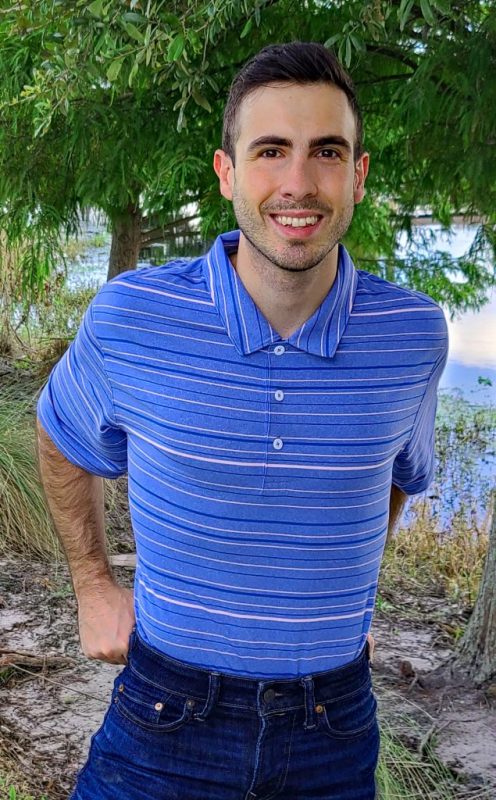 What is more patriotic than a golf polo that pays tribute to Betsy Ross? The MATTR Volition Betsy Ross Pocket Golf Polo features all of the great technology of the MATTR fabric and adds a very subtle feature, a pocket with an American Flag on it. It’s available in sizes S – 3XL and in either Bright White or Quiet Shade. There’s a Volition Lockup logo on the back of the neck.
What is more patriotic than a golf polo that pays tribute to Betsy Ross? The MATTR Volition Betsy Ross Pocket Golf Polo features all of the great technology of the MATTR fabric and adds a very subtle feature, a pocket with an American Flag on it. It’s available in sizes S – 3XL and in either Bright White or Quiet Shade. There’s a Volition Lockup logo on the back of the neck.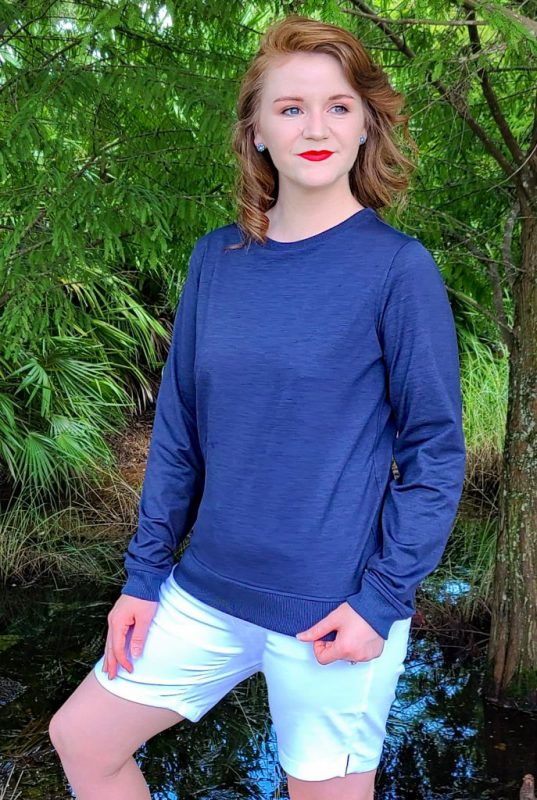 moisture-wicking fabric keeps you cool and dry. They are very lightweight and the elastic waistband is quite comfortable. The zippered stash pockets are big enough to hide your golf necessities and the zipper ensures you won’t lose your stuff. These great looking shorts are available in sizes S – 3XL and if you want to complete the look, there’s a matching Sabbatical Polo.
moisture-wicking fabric keeps you cool and dry. They are very lightweight and the elastic waistband is quite comfortable. The zippered stash pockets are big enough to hide your golf necessities and the zipper ensures you won’t lose your stuff. These great looking shorts are available in sizes S – 3XL and if you want to complete the look, there’s a matching Sabbatical Polo.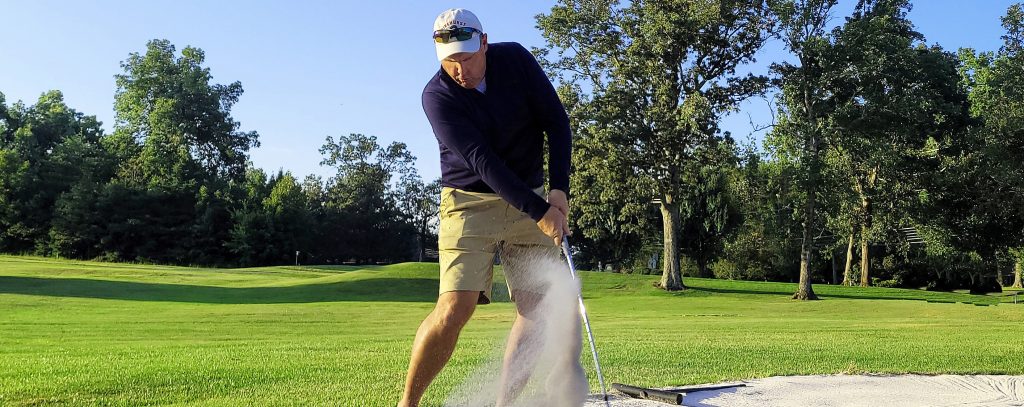 PUMA has given the ladies a number of options for this upcoming golf season. PUMA’s Pounce Shorts have been around a while, which proves the point if it ain’t broke, don’t fix it! These must-have Bermuda shorts are packed with style and will go perfectly with just about any top you have hanging in your closet. They have a 9.25″ inseam for extra sun protection and a half elastic waistband for added stretch, comfort and unrestricted range of motion. PUMA’s DRYCELL Technology helps wick moisture away from the skin to keep you dry and comfortable. The Women’s Pounce Bermuda Shorts are available in sizes XXS – XXL and in 8 vibrant solid colors.
PUMA has given the ladies a number of options for this upcoming golf season. PUMA’s Pounce Shorts have been around a while, which proves the point if it ain’t broke, don’t fix it! These must-have Bermuda shorts are packed with style and will go perfectly with just about any top you have hanging in your closet. They have a 9.25″ inseam for extra sun protection and a half elastic waistband for added stretch, comfort and unrestricted range of motion. PUMA’s DRYCELL Technology helps wick moisture away from the skin to keep you dry and comfortable. The Women’s Pounce Bermuda Shorts are available in sizes XXS – XXL and in 8 vibrant solid colors. The CLOUDSPUN Colorblock Golf Crew delivers an ultra-soft feel with four-way stretch, moisture-wicking and all the performance needed to play 18. And it will keep you warm on those cool mornings. It’s sewn from a Jersey material with added sun protection woven into the fabric. The Cat logo on the left hip lets your playing partners know your favorite brand. The Colorblock Crew is available in sizes XS – 2XL and in 4 color combinations: White/Navy, Blue Spruce/ Cloud Pink, Navy Blazer/Scuba Blue, and Lavender/Navy. It’s also available in solid colors. The Women’s CLOUDSPUN Golf Crewneck is also available in sizes XS – 2XL and in Bright White, Navy Blazer, PUMA Black or Light Gray Heather. Same great look. Same great feel. Cat logo on the left hem.
The CLOUDSPUN Colorblock Golf Crew delivers an ultra-soft feel with four-way stretch, moisture-wicking and all the performance needed to play 18. And it will keep you warm on those cool mornings. It’s sewn from a Jersey material with added sun protection woven into the fabric. The Cat logo on the left hip lets your playing partners know your favorite brand. The Colorblock Crew is available in sizes XS – 2XL and in 4 color combinations: White/Navy, Blue Spruce/ Cloud Pink, Navy Blazer/Scuba Blue, and Lavender/Navy. It’s also available in solid colors. The Women’s CLOUDSPUN Golf Crewneck is also available in sizes XS – 2XL and in Bright White, Navy Blazer, PUMA Black or Light Gray Heather. Same great look. Same great feel. Cat logo on the left hem.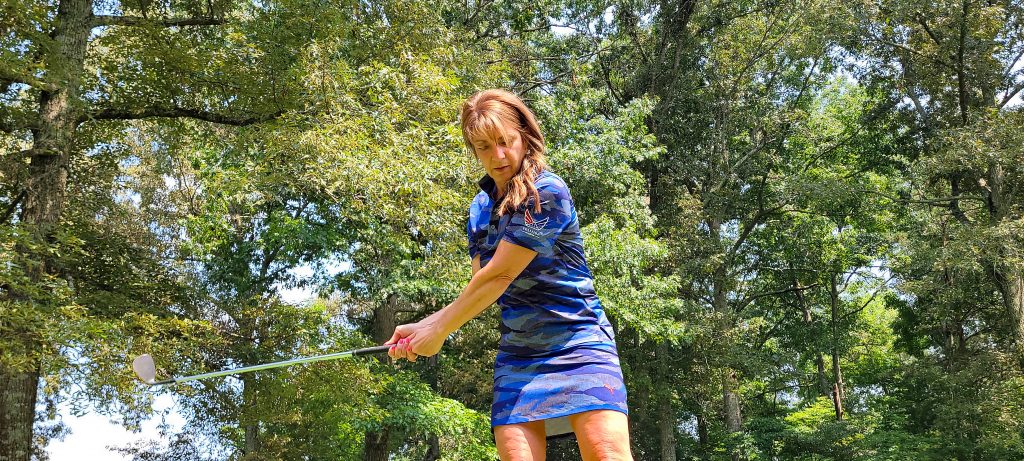 The Juniors Volition Camo Golf Polo is not your average camo. For starters, it’s sewn from a high-performance fabric that will keep you dry, comfortable, and protected from the sun. Secondly, the camo pattern will easily make you the best dressed in your group. Thirdly, the support you are giving the Folds of Honor cannot be beaten. Proceeds from this purchase will support the families of our American military heroes. This snazzy camo polo is available in sizes XS – XL and in a Blue/Gray camo design.
The Juniors Volition Camo Golf Polo is not your average camo. For starters, it’s sewn from a high-performance fabric that will keep you dry, comfortable, and protected from the sun. Secondly, the camo pattern will easily make you the best dressed in your group. Thirdly, the support you are giving the Folds of Honor cannot be beaten. Proceeds from this purchase will support the families of our American military heroes. This snazzy camo polo is available in sizes XS – XL and in a Blue/Gray camo design.
 Darl and Letha are the matriarch and patriarch of the Scott family and were the first generation of Scotts to be involved with the property. Darl used to be the superintendent at nearby Gull Lake Country Club and the couple also owned the Gull Lake Motel. The Scotts sold the motel to get the funds to build their first course, Gull Lake View West, which opened in 1965.
Darl and Letha are the matriarch and patriarch of the Scott family and were the first generation of Scotts to be involved with the property. Darl used to be the superintendent at nearby Gull Lake Country Club and the couple also owned the Gull Lake Motel. The Scotts sold the motel to get the funds to build their first course, Gull Lake View West, which opened in 1965. Number 6. From the Back Tees, the hole plays 192 yards. The small green is protected by bunkers on either side. Your best bet is to hit your tee shot short and right of the pin as balls tend to bounce hard left. Gull Lake view will have you hitting every club in your bag at least once.
Number 6. From the Back Tees, the hole plays 192 yards. The small green is protected by bunkers on either side. Your best bet is to hit your tee shot short and right of the pin as balls tend to bounce hard left. Gull Lake view will have you hitting every club in your bag at least once. small landing area. The water on the left comes into play at about 235 yards with trees on the right. Water comes into play again, guarding the front of the green. It may be one of the shortest par 4s out here but it’s also a good test of golf. Director of Golf, Dean Kolstad feels that number 18 is the toughest finishing hole of any of the Gull Lake Resort courses. It’s a dogleg right that plays slightly downhill off the tee then at least one club extra into the green, which is protected on the left side by a bunker. There’s nothing wrong with a par to end your round.
small landing area. The water on the left comes into play at about 235 yards with trees on the right. Water comes into play again, guarding the front of the green. It may be one of the shortest par 4s out here but it’s also a good test of golf. Director of Golf, Dean Kolstad feels that number 18 is the toughest finishing hole of any of the Gull Lake Resort courses. It’s a dogleg right that plays slightly downhill off the tee then at least one club extra into the green, which is protected on the left side by a bunker. There’s nothing wrong with a par to end your round. At this point, there is no stopping the Scotts! Their next course would be located about three miles down the highway from the original two courses. Stonehedge South was built by Darl’s son Charles and opened in 1988. Stonehedge South has been included in Golf Digest’s list of the top 75 most affordable courses in the United States. There are several tight tree-lined holes to keep you honest off the tee and thinking about your next shot. The greens are well-undulated and worthy of a look from more than one angle. Although it’s ranked as one of the easier holes on the course, Number 17 has a lot of character. It’s a 478-yard par 5 double dogleg right with a fairway bunker on the left side off the tee. Woods and out of bounds on the right. A good drive down the left side past the bunker will give you the green light to go for the green in two. You’ll need to hit it high as a large tree sits about 100 yards from the green. There’s a very deep bunker that guards the front of the green, which is long and well sloped. Hit it over the green and par becomes difficult. Like all the courses at the resort, the South is well-maintained and staffed by truly friendly people. It’s part of what makes this family-owned resort so popular.
At this point, there is no stopping the Scotts! Their next course would be located about three miles down the highway from the original two courses. Stonehedge South was built by Darl’s son Charles and opened in 1988. Stonehedge South has been included in Golf Digest’s list of the top 75 most affordable courses in the United States. There are several tight tree-lined holes to keep you honest off the tee and thinking about your next shot. The greens are well-undulated and worthy of a look from more than one angle. Although it’s ranked as one of the easier holes on the course, Number 17 has a lot of character. It’s a 478-yard par 5 double dogleg right with a fairway bunker on the left side off the tee. Woods and out of bounds on the right. A good drive down the left side past the bunker will give you the green light to go for the green in two. You’ll need to hit it high as a large tree sits about 100 yards from the green. There’s a very deep bunker that guards the front of the green, which is long and well sloped. Hit it over the green and par becomes difficult. Like all the courses at the resort, the South is well-maintained and staffed by truly friendly people. It’s part of what makes this family-owned resort so popular. Bedford Valley was the fourth Gull Lake View course and is the only course not on the Augusta property. It’s located about 20 minutes away in Battle Creek and was designed in 1965 by William Mitchell. Bedford Valley was purchased by the Scott Family in 1988 and is known for its fairways lined with majestic oak trees, oversized bunkers, and large, sweeping greens. Since purchasing the property, the Scott family has added a complete practice facility with a full-length driving range and large putting green.
Bedford Valley was the fourth Gull Lake View course and is the only course not on the Augusta property. It’s located about 20 minutes away in Battle Creek and was designed in 1965 by William Mitchell. Bedford Valley was purchased by the Scott Family in 1988 and is known for its fairways lined with majestic oak trees, oversized bunkers, and large, sweeping greens. Since purchasing the property, the Scott family has added a complete practice facility with a full-length driving range and large putting green. Gull Lake View’s fifth course, Stonehedge North, was designed by Charles and Jon Scott and opened in 1995. If you like golf courses with a lot of trees and dramatic elevation changes, you will fall in love with Stonehedge North. The course is made up of six par threes, six par fours, and six par fives and is wide open compared to the South Course. The front nine is relatively open and flat, while the back nine is wooded with significant elevation changes. The greens tend to be on the large side and can leave some long putts on poorly hit approach shots. The course ends with an interesting par 5; a 527-yard dogleg left. Calling it a dogleg is an understatement; the hole turns 90 degrees to the left at the top of the hill. The fairway bunker on the left side is about 200 yards off the tee, so if you can carry it off the tee, you can shave some yardage off. Fairway bunkers also come into play on your layup shot on either side of the fairway. Navigate them successfully and you’ll leave a short pitch into a green. A back-left pin position may pose a problem as you’ll have a large tree and bunker to contend with. Par is a great way to end your round.
Gull Lake View’s fifth course, Stonehedge North, was designed by Charles and Jon Scott and opened in 1995. If you like golf courses with a lot of trees and dramatic elevation changes, you will fall in love with Stonehedge North. The course is made up of six par threes, six par fours, and six par fives and is wide open compared to the South Course. The front nine is relatively open and flat, while the back nine is wooded with significant elevation changes. The greens tend to be on the large side and can leave some long putts on poorly hit approach shots. The course ends with an interesting par 5; a 527-yard dogleg left. Calling it a dogleg is an understatement; the hole turns 90 degrees to the left at the top of the hill. The fairway bunker on the left side is about 200 yards off the tee, so if you can carry it off the tee, you can shave some yardage off. Fairway bunkers also come into play on your layup shot on either side of the fairway. Navigate them successfully and you’ll leave a short pitch into a green. A back-left pin position may pose a problem as you’ll have a large tree and bunker to contend with. Par is a great way to end your round. Stoatin Brae is not only the newest course at Gull Lake View but also their crowning jewel. The course was built by the Scott family with a little input and help from Tom Doak’s Renaissance Golf Company. Translated from Gaelic, Stoatin Brae means Grand Hill and since the course sits on the highest point in Kalamazoo County, it just makes sense! The course can be described in 4 words: fast, firm, and wide open (and doesn’t count)! When the wind is up, you’ll have a good idea of what it’s like to play golf in Scotland. The course plays 6,667 yards from the tips with a course rating of 71.5 and a slope of 122. You’ll have to shoot a 71 if you want to play par golf here. And it’s priced right too. It’s probably one of the best golf values in the country. There are no water hazards at Stoatin’ Brae. But what it lacks in water, it makes up for in strategically placed bunkers and challenging green complexes. And if the wind’s blowing, you’ll forget all about the lack of water. At 336 yards, the 10th hole is relatively short however as you stand on the tee, you can’t help but wonder where is the best place to hit your tee shot? As it turns out, a long drive down the left side and over the hill provides the best angle into the green. If you can see your tee shot when it lands, you’ll probably have a tougher approach shot. Several rugged bunkers guard the green.
Stoatin Brae is not only the newest course at Gull Lake View but also their crowning jewel. The course was built by the Scott family with a little input and help from Tom Doak’s Renaissance Golf Company. Translated from Gaelic, Stoatin Brae means Grand Hill and since the course sits on the highest point in Kalamazoo County, it just makes sense! The course can be described in 4 words: fast, firm, and wide open (and doesn’t count)! When the wind is up, you’ll have a good idea of what it’s like to play golf in Scotland. The course plays 6,667 yards from the tips with a course rating of 71.5 and a slope of 122. You’ll have to shoot a 71 if you want to play par golf here. And it’s priced right too. It’s probably one of the best golf values in the country. There are no water hazards at Stoatin’ Brae. But what it lacks in water, it makes up for in strategically placed bunkers and challenging green complexes. And if the wind’s blowing, you’ll forget all about the lack of water. At 336 yards, the 10th hole is relatively short however as you stand on the tee, you can’t help but wonder where is the best place to hit your tee shot? As it turns out, a long drive down the left side and over the hill provides the best angle into the green. If you can see your tee shot when it lands, you’ll probably have a tougher approach shot. Several rugged bunkers guard the green. Although the majority of Gull Lake View’s guests come from Detroit, Chicago, and Toledo, it’s not uncommon to meet golfers from Cincinnati, and Wisconsin, and Canada while you’re there. Golfers may come out to just play Stoatin Brae but once they get a feel for one of the other courses, they’re hooked! And at Gull Lake View, there is something for everyone. For more information or to book your next golf outing or vacation at Gull Lake View Golf Resort, visit them online at
Although the majority of Gull Lake View’s guests come from Detroit, Chicago, and Toledo, it’s not uncommon to meet golfers from Cincinnati, and Wisconsin, and Canada while you’re there. Golfers may come out to just play Stoatin Brae but once they get a feel for one of the other courses, they’re hooked! And at Gull Lake View, there is something for everyone. For more information or to book your next golf outing or vacation at Gull Lake View Golf Resort, visit them online at 
 Number 18 is a great finishing hole and if you can hit a draw off the tee, now’s a good time to do it. From the White tees, the hole plays 388 yards. There’s a lake that guards the front of the green about 85 yards out, so choose your approach club wisely. There’s a couple of sand traps left of the green as well as water and more sand right and long. Par is a great way to finish your round.
Number 18 is a great finishing hole and if you can hit a draw off the tee, now’s a good time to do it. From the White tees, the hole plays 388 yards. There’s a lake that guards the front of the green about 85 yards out, so choose your approach club wisely. There’s a couple of sand traps left of the green as well as water and more sand right and long. Par is a great way to finish your round. Off course renovations continue. The Clubhouse has been torn down and replaced with a 107 room Fairfield Inn and Suites that is scheduled to open in the fall of 2021. The old cart barn has been replaced with an 11,000-square-foot state-of-the-art clubhouse with banquet and meeting facilities for 250 people. The new restaurant – The View at Colony West – is open to the public, golfers, and hotel guests alike. The new pro shop recently opened and has all of your favorite logoed apparel and everything else you need for a great round of golf.
Off course renovations continue. The Clubhouse has been torn down and replaced with a 107 room Fairfield Inn and Suites that is scheduled to open in the fall of 2021. The old cart barn has been replaced with an 11,000-square-foot state-of-the-art clubhouse with banquet and meeting facilities for 250 people. The new restaurant – The View at Colony West – is open to the public, golfers, and hotel guests alike. The new pro shop recently opened and has all of your favorite logoed apparel and everything else you need for a great round of golf. Galuppi’s Restaurant – located at the clubhouse of the Pompano Beach Golf Club – is destined to become not only one of the area’s best eateries but also one of the most popular entertainment venues. The vision of proprietor Grant Galuppi is to create a space where visitors and people within the community can eat, meet, and mingle and enjoy some live entertainment. There’s live music just about every night and everything we ordered off the menu was delicious. Once everything is completed – sometime in probably 2025 – the Pompano Beach Golf complex will rival any other public golf facility in the state. Get out early and do a before and after and see for yourself!
Galuppi’s Restaurant – located at the clubhouse of the Pompano Beach Golf Club – is destined to become not only one of the area’s best eateries but also one of the most popular entertainment venues. The vision of proprietor Grant Galuppi is to create a space where visitors and people within the community can eat, meet, and mingle and enjoy some live entertainment. There’s live music just about every night and everything we ordered off the menu was delicious. Once everything is completed – sometime in probably 2025 – the Pompano Beach Golf complex will rival any other public golf facility in the state. Get out early and do a before and after and see for yourself! While in the area, you’ll need a place to lay your head at night. I strongly suggest Cottages By The Ocean on SE 3rd St. in Pompano Beach. Not only are they centrally located to several public-accessible golf courses, but they’re also a block and a half from the beach and all kinds of restaurants and nightlife. These 1940s-era cottages and one-bedroom bungalows offer full kitchens with range, refrigerator, and microwave, a complete living room, and a king-size bed. They’ve also got you covered if you’re headed to the beach with beach chairs, wakeboards, and beach toys. Owner Elaine Fitzgerald likes to greet each guest personally and when you see her ask her for some restaurant recommendations. She’s been in the area a long time and is well-connected. She has several similar properties in the area so if the Cottages By The Ocean are booked, check out her other locations.
While in the area, you’ll need a place to lay your head at night. I strongly suggest Cottages By The Ocean on SE 3rd St. in Pompano Beach. Not only are they centrally located to several public-accessible golf courses, but they’re also a block and a half from the beach and all kinds of restaurants and nightlife. These 1940s-era cottages and one-bedroom bungalows offer full kitchens with range, refrigerator, and microwave, a complete living room, and a king-size bed. They’ve also got you covered if you’re headed to the beach with beach chairs, wakeboards, and beach toys. Owner Elaine Fitzgerald likes to greet each guest personally and when you see her ask her for some restaurant recommendations. She’s been in the area a long time and is well-connected. She has several similar properties in the area so if the Cottages By The Ocean are booked, check out her other locations.


